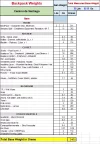I like your video Rob. My thoughts are that it will serve as a terrific reference for beginners and gives good food for thought to those who are experienced walkers. Thank you for your efforts.





As I was debating with myself about adding my two cents, it occurred to me that, first and foremost, experienced walkers - be they pilgrims or backpackers on through hikes - know what they want to bring, have developed a 'system' of how to use what they bring, and there is really no notion of what is 'better or worse' in terms of contents in a backpack. A case in point: you like your water bottle system, and I prefer a water reservoir/bladder. The accomplish the same thing, are equally easy to deal with and fill, but it is how we choose to interact with those two systems which define our preferences.
In my mind, it is less about what one decides to carry, it is about IF what is carried is fully utilized, and if that item choice gives you a good weight-to-cost ratio. There are some choices that help with the adage that ounces equal pounds, and pounds equal pain.
Novices are different. They do not know what they do not know. So this type of thread, and your video, are exceedingly helpful in drilling down to essentials. It helps whittle away the beginner's 'packing your fears' dilemma, which helps to reduce the weight carried.
What is the difference in how an experienced walker packs and a newbie/novice: One packs with fear and what-ifs; the other packs with knowledge and experience.
For clothing, as an example. For temperature ranges from 28F (-2c) to blazing hot, my clothes closet in my pack weighs about 3.7 pounds (1.72kg) and takes up very little space. My knowledge - shared by many here - on how to layer, and with what fabric materials to have in my clothing, keeps me from needing a backpack full of clothes weighing 10 pounds or more.
And that knowledge and experience carries over into each and every gear choice made. As novices gain knowledge, their burden gets lighter and their enjoyment grows.
Gear and clothing choices
do not have to be expensive, either. A Camino-only backpack only needs to last as long as a Camino walk. That means that lesser quality materials and construction are just fine. Find the least expensive gear that gives you the comfort and usability you want. And nowadays, inexpensive gear that is lighter in weight does
not need to equal junk which will fall apart after a week of walking.
Technological innovations in materials and manufacturing may inform us of changes which we may decide to make. An example are down garments. Nowadays down jackets, sleeping quilts, vests, etc are treated with a hydrophobic compound. It adds no weight, no smell, no chemical negatives.
What it does do is allow me to use down in a manner that I wouldn't use it decades ago when I first started backpacking and climbing. I can take my down sleeping quilt, throw it in a lake, and the water does not saturate and collapse the down. It remains just as insulative as ever. Of course the fabric nylon shell is wet and needs to dry out, but the down simply sheds the water.
That made me trade in my polartec for down with my vest and puffy. New synthetics like my Nano Air jacket is pretty light for a synthetic, but not as light as an 800 fill down.
When I return to the Camino, this is my packing list. This is what is in the backpack. Note that this is a base weight measurement which does NOT include water or snacks. If backpacking, my base weight increases by about 3.8 pounds (1.7 kg), which adds my tent, mattress, and cooking gear, and a few other ancillaries for wilderness travel.
This is also for 3-season use from the middle of spring thru middle fall. Increasing extremes from cold weather would change what goes into my 'house'.
I attempted to add the weight measurements in grams, but I think there is a discrepancy of being 'light' by 400+/- grams during my attempts at converting the sums.
View attachment 93881



























